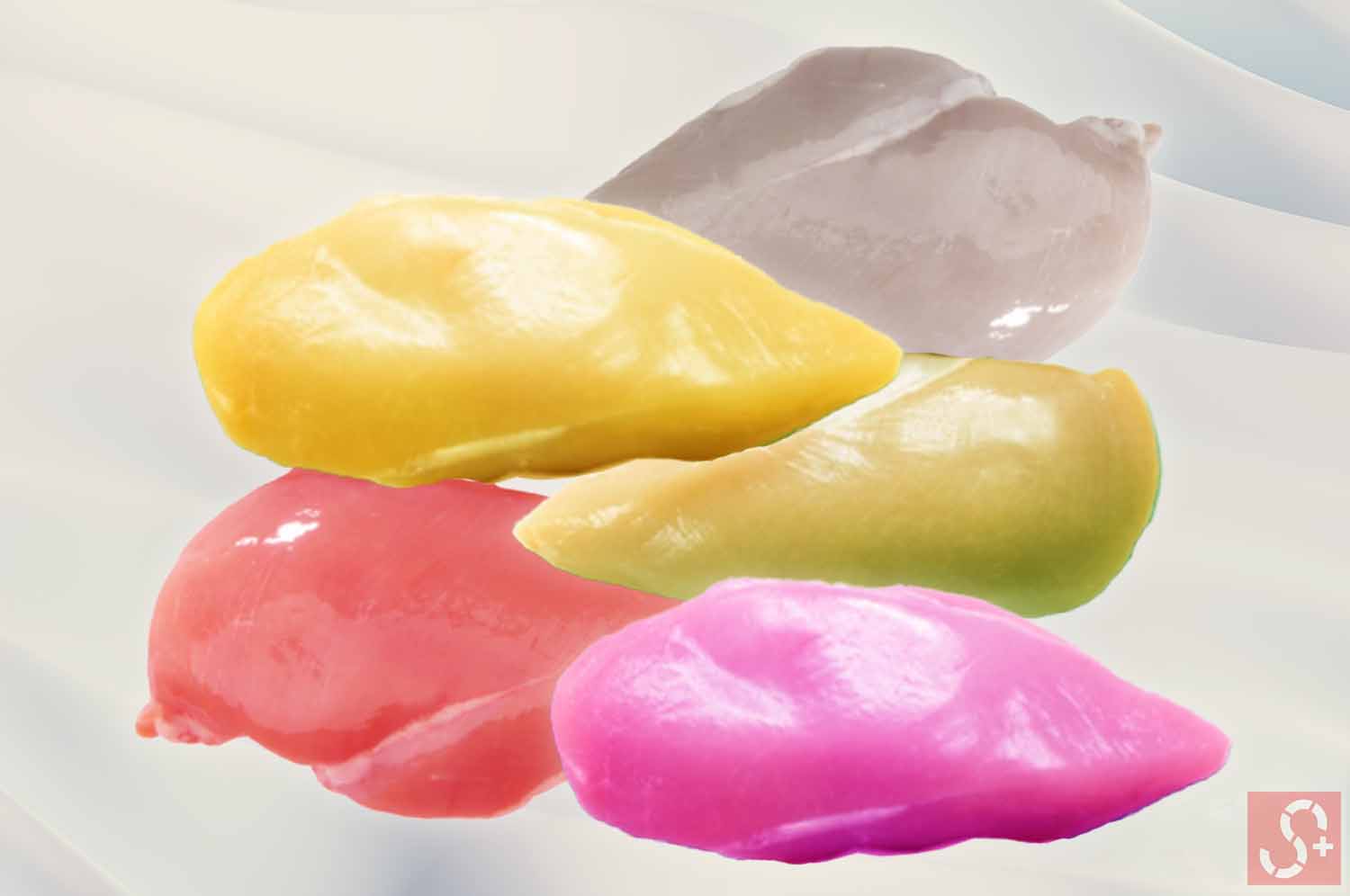Note: Regardless of color, never consume meat if unsure. Feel free to discard it when in doubt because health is more important!
You opened a pack of chicken breasts but noticed a different color. So what does it mean, and why does chicken breast change color?
Key Takeaways:
If the color of the chicken breast changes and you observe patches of gray, green, or yellow, usually it indicates the chicken is spoiled. Color changes mean a spoiling process is starting, but it doesn’t always suggest a product is spoilt. Off-odor is the best sign of deterioration.
| Chicken Breast Color | Description |
| Gray | It has gone bad |
| Yellow | It has gone bad, but if the whole chicken is yellow, it could be because of the gene and the feeding given to it. |
| Green | Unusual color; an indication of spoilage. It also contributes to a sickness in the chicken. |
| Light Pink | The best and the most preferred color |
| Purple | Color due to the pigment present in the meat |
| Red | Color leaching from the bone marrow |
| Orange | The meat has faded from its original color |
| Black | Indicates the chicken has gone bad |
| White | Usually it happens as a result of a freezer burn |
Read on to know more about the various color changes in the chicken breast, the underlying reasons, and how to tell if it is bad.
What Does It Mean When The Chicken Breast Changes Color?
The color of raw chicken is generally light pink, but if it changes to any unusual colors like gray, green, or yellow – it means the chicken has gone bad, and you need to discard it. That said, there’s more to why the color change occurs.
Gray Color In Chicken Breast
One of the most crucial signs of spotting bad chicken breasts is looking for grayish patches—the hue of spoiled chicken changes from pink to a dull gray. So discard any chicken that looks gray.
Yellow Color In Chicken Breast
Usually, if you notice yellow spots on the chicken, they like the gray color – it’s also a sign of deterioration. And it is best to stay away from such chicken breasts.
That said, sometimes you may see raw chicken available in full (overall) yellow color. And most of the time, that’s not a sign of spoilage. Instead, it’s more related to the gene and the feeding given to that chicken.
Genes and diet both have a role in whether or not a chicken’s skin becomes yellow. Gray jungle fowl genes always produce a yellowish hue in the skin and occasionally the meat of chickens.
Chickens with a diet rich in carotene from foods like maize, marigold, paprika, and the like will develop a yellowish hue. In short, if the chicken is rotten, has an excessive blood scent, or only yellow patches on a pinkish (faded color) chicken – it’s a sign to stay. Otherwise, an entire yellow chicken is not a warning indicator.
Green Color In Chicken Breast
The occurrence of an odd green hue in chicken flesh is generally attributable to a sickness known as Green Muscle Disease (formerly known as Oregon Disease) that affects commercially raised broiler chickens.
In the poultry business, broiler chicks are permitted to spend their developmental years in a relatively immobile state. As a direct result, the pectoral muscles, commonly known as the breast muscles, do not receive adequate exercise to improve their circulatory supply efficiency.
Due to the inability of chicken muscles to expand in response to physical activity, even a brief period of rapid and excessive wing flapping can restrict blood flow, leading to tissue degeneration and cell death.
The damaged muscle produces a characteristic lesion that is reddish-brown and swollen. Depending on when the vigorous wing activity started, this lesion becomes green, shrinks, and finally turns light green.
The lesion has no effect on the overall health and is frequently identified during the process of cutting and deboning the birds. The only impact it has on the visual appearance of the meat is to make it appear less appealing.
The condition is not related to infectious or harmful substances. Due to the situation, the food’s safety is not affected in general.
Red Color In Chicken Breast
When a bird is frozen and then thawed, this process can occasionally cause pigment to seep out of the bone marrow and collect as a dark red hue around the bone. You may also observe it in the portion of the flesh that is situated just adjacent to the bone.
Orange Color In Chicken Breast
The normal color of the fresh chicken breast is light pink. But when it starts fading, usually you notice an orangish hue. And to be on the safe side – chicken that has gotten faded or lighter in color compared to when it was frozen, or if it has, on the other hand, become darker, it is no longer safe to eat.
Black Color In Chicken Breast
Some color changes in raw chicken are okay. However, graying or the deepening of some patches (to black) suggest deterioration.
Purple Color In Chicken Breast
Myoglobin is one of the two primary pigments that determine the color of meat. When meat is fresh and kept from contact with air (such as in vacuum packing), it has the purple-red hue that comes from myoglobin. Myoglobin is responsible for the color of fresh meat.
White Color In Chicken Breast
Most often, the white color in the chicken breast is the result of freezer burn. A Freezer burn refers to the white tint that develops on the exterior of meat after it has been stored in the freezer for an extended period of time.
It is due to the top surface being dry as a result of losing moisture. Although it does not compromise the safety of the meat in any way, the taste may be off at times.
Why Does Chicken Breast Change Color?
The short answer to that is the underlying chemical changes that happen during the transportation and storage of the chicken breast. Once the food starts to spoil and bacterial growth begins, it changes its color.
Then, all the spoilage signs are noticed.
Bacteria growth reduces oxygen levels in the environment, which alters meat coloring (source).
Raw Vs. Cooked Chicken Breast Color Change
The ideal raw chicken’s color includes light pinkish with a few white-fatty parts. If you notice the raw chicken breast with green, gray, or yellow, that indicates deterioration and should be tossed out as a result. However, a minor color change in the raw chicken breast is okay.
Chicken that has been adequately cooked will have a white color and will not have any pink parts. Uncooked chicken can be identified by its pinkish-red meat. If there are any spices or dressings on the chicken, it will be challenging to see mold or color changes before they become noticeable. Hence, you should eat the chicken by three days – after you’ve cooked it.
How To Identify When The Chicken Breast Is Bad?
Several checks can be made to find out if the chicken breast is bad or not, as follows:
Touch Check: Put your clean hands on the chicken and notice whether it feels slimy or sticky. We recommend discarding any chicken that is too slick to grasp. Always remember to clean your hands thoroughly afterward.
Smell Check: No strong smells should be detectable on fresh chicken. Instead of attempting to smell the chicken through the plastic, it is best to take the box out of the fridge, let it sit for a few minutes, and then open it.
Visual Check: The visual test involves the inspection of the color of the chicken. A change in color is not always indicative of spoilage (source). Color changes are common in fresh items. Discoloration or darkening may accompany deterioration, though.
The meat or poultry will change color and could also smell odd, feel sticky or slimy, or be sticky to the touch. If the chicken breast has acquired these qualities, it is unsafe to consume.
How To Pick The Most Fresh Chicken Breast?
A press test is one of the best ways to identify if a chicken breast is the freshest. In the test, you are supposed to press the chicken breast with your fingers and pull it off your hands. Then observe how quickly the muscular tissues of the chicken breast return to their original state.
If the chicken stays around for a while, tissues will bounce back much slower than a fresh one. When you press the surface of a fresh chicken breast, it would quickly bounce back to its original position, which is a good indication that it is fresh.
Apart from these, you can do a visual check and choose the one with the light pinkish color. And steer away from anything that has those grayish colors.








